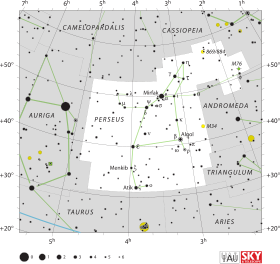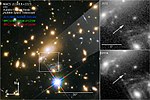astro.wikisort.org - Star
V392 Persei, also known as Nova Persei 2018, is a bright nova in the constellation Perseus discovered on April 29, 2018. It was previously known as a dwarf nova.
 | |
| Observation data Epoch J2000.0 Equinox J2000.0 | |
|---|---|
| Constellation | Perseus |
| Right ascension | 04h 43m 21.37s[1] |
| Declination | +47° 21′ 25.9″[1] |
| Apparent magnitude (V) | 6.3 - 16.9[2] |
| Characteristics | |
| B−V color index | +1.0[3] |
| V−R color index | +0.9[3] |
| Variable type | dwarf nova & nova[1] |
| Astrometry | |
| Proper motion (μ) | RA: 0.193[4] mas/yr Dec.: −1.749[4] mas/yr |
| Parallax (π) | 0.2573 ± 0.0516 mas[4] |
| Distance | 4161+2345 −440[5] pc |
| Absolute magnitude (MV) | −10.1 (max)[6] |
| Other designations | |
| Database references | |
| SIMBAD | data |
Dwarf nova
A U Geminorum-type variable star or dwarf nova is a type of cataclysmic variable star consisting of a close binary star system in which one of the components is a white dwarf that accretes matter from a cool main sequence or subgiant companion.[8] V392 Persei was discovered in 1970 and received its variable star designation a year later. It is normally visual magnitude 17.4 and experiences outbursts of 2-3 magnitudes.[1] Its spectrum in the quiescent state has been studied and only the cool star is detected. The spectrum shows emission lines of hydrogen-alpha (Hα) and both neutral and ionised helium.[3] The brightest recorded observations is at magnitude 5.6.[6]
Nova eruption

On April 29, 2018 it was discovered by Yuji Nakamura to be extremely bright, and it was spectroscopically confirmed as a nova outburst with magnitude 6.2 on April 30. The spectrum includes broad Hα and FeII emission lines with P Cygni profiles. The absorption core is blueshifted by a velocity of 2,680 km/s, which would be the expansion velocity from the nova explosion.[9]
Observations with Fermi-LAT on April 30 show a strong gamma-ray source at the coordinates of the nova.[10] Photometry of the nova from Konkoly Observatory on May 1, 2018 give apparent magnitudes of 7.38 in the V band and 8.22 in the B band, suggesting it is already declining.[11]
System
V392 Persei is the southern of a pair of stars separated by 8.5".[2]
The symbiotic pair are unresolved, with an orbital period of only 3.21997 days,[12] and the nature of the cool component is unclear. The spectral energy distribution is inconsistent with a bright giant star but it could be less luminous red clump giant or subgiant. If the cool component was a main sequence red dwarf as expected for a dwarf nova, then the system would need to be closer than the 13,000 ly suggested by its Gaia parallax.[6]
Gallery
- Dwarf nova V392 Persei over the ESO Supernova Planetarium & Visitor Centre.[13]
- V392 Persei, 2 May 2018, 22:00 UT. The slightly fainter nearby star is 9th magnitude BD+47°1026. Up is approximately east.
See also
References
- Samus, N. N.; Durlevich, O. V.; et al. (2009). "VizieR Online Data Catalog: General Catalogue of Variable Stars (Samus+ 2007-2013)". VizieR On-line Data Catalog: B/GCVS. Originally Published in: 2009yCat....102025S. 1. Bibcode:2009yCat....102025S.
- Watson, C. L. (2006). "The International Variable Star Index (VSX)". The Society for Astronomical Sciences 25th Annual Symposium on Telescope Science. Held May 23–25. 25: 47. Bibcode:2006SASS...25...47W.
- Liu, Wu; Hu, J. Y (2000). "Spectroscopic Confirmation of Northern and Equatorial Cataclysmic Variables. III. 32 Poorly Known Objects". The Astrophysical Journal Supplement Series. 128 (1): 387–401. Bibcode:2000ApJS..128..387L. doi:10.1086/313380.
- Brown, A. G. A.; et al. (Gaia collaboration) (August 2018). "Gaia Data Release 2: Summary of the contents and survey properties". Astronomy & Astrophysics. 616. A1. arXiv:1804.09365. Bibcode:2018A&A...616A...1G. doi:10.1051/0004-6361/201833051.
- Schaefer, Bradley E. (2018). "The distances to Novae as seen by Gaia". Monthly Notices of the Royal Astronomical Society. 481 (3): 3033–3051. arXiv:1809.00180. Bibcode:2018MNRAS.481.3033S. doi:10.1093/mnras/sty2388. S2CID 118925493.
- Darnley, M. J; Starrfield, S (2018). "On the Progenitor System of V392 Persei". Research Notes of the AAS. 2 (2): 24. arXiv:1805.00994. Bibcode:2018RNAAS...2b..24D. doi:10.3847/2515-5172/aac26c. S2CID 119486187.
- "V392 Per". SIMBAD. Centre de données astronomiques de Strasbourg. Retrieved 2019-08-25.
- N.N. Samus; O.V. Durlevich (February 12, 2009). "GCVS Variability Types and Distribution Statistics of Designated Variable Stars According to their Types of Variability". Retrieved 2013-02-08.
- R. M. Wagner; D. Terndrup; M. J. Darnley; S. Starrfield; C. E. Woodward; M. Henze. "Optical Spectroscopy of TCP J04432130+4721280 (V392 Per) Confirms a Nova Eruption". Retrieved 2018-05-02.
- Kwan-Lok Li; Laura Chomiuk; Jay Strader. "Bright gamma-ray emission from TCP J04432130+4721280 (V392 Per) detected by Fermi-LAT". Retrieved 2018-05-02.
- R. Konyves-Toth; B. Csak; A. Pal; J. Vinko. "Optical Photometry of the Nova Outburst TCP J04432130+4721280 (V392 Per)". Retrieved 2018-05-02.
- Schaefer, Bradley E. (2021). "Discovery of 13 New Orbital Periods for Classical Novae". Research Notes of the AAS. 5 (6): 150. arXiv:2106.13907. Bibcode:2021RNAAS...5..150S. doi:10.3847/2515-5172/ac0d5b. S2CID 235632263.
- "Nova over Supernova". www.eso.org. Retrieved 7 May 2018.
External links
- Dwarf Nova V392 Persei Goes Big — It’s Now Binocular Bright
- How A Dwarf Nova Hit The Big Time May 2, 2018
- Nova in Perseus
- V392 Per in outburst, showing spectra of the nova in outburst and previously
На других языках
[de] Nova Persei 2018
Die Nova Persei 2018 war eine helle Nova die am 29. April 2018 im Sternbild Perseus entdeckt wurde. Zuvor war sie am 16. Februar 1970 als Zwergnova V392 Per von Gerold Alfred Richter aus Sonneberg gemeldet worden.[3]- [en] V392 Persei
[ru] Новая Персея 2018
Новая Персея 2018 — яркая новая звезда, открытая в созвездии Персея 29 апреля 2018 года. Ранее была известна как карликовая новая и имела обозначение V392 Персея.Другой контент может иметь иную лицензию. Перед использованием материалов сайта WikiSort.org внимательно изучите правила лицензирования конкретных элементов наполнения сайта.
WikiSort.org - проект по пересортировке и дополнению контента Википедии
![Dwarf nova V392 Persei over the ESO Supernova Planetarium & Visitor Centre.[13]](http://upload.wikimedia.org/wikipedia/commons/thumb/e/e3/Nova_over_Supernova.jpg/120px-Nova_over_Supernova.jpg)


